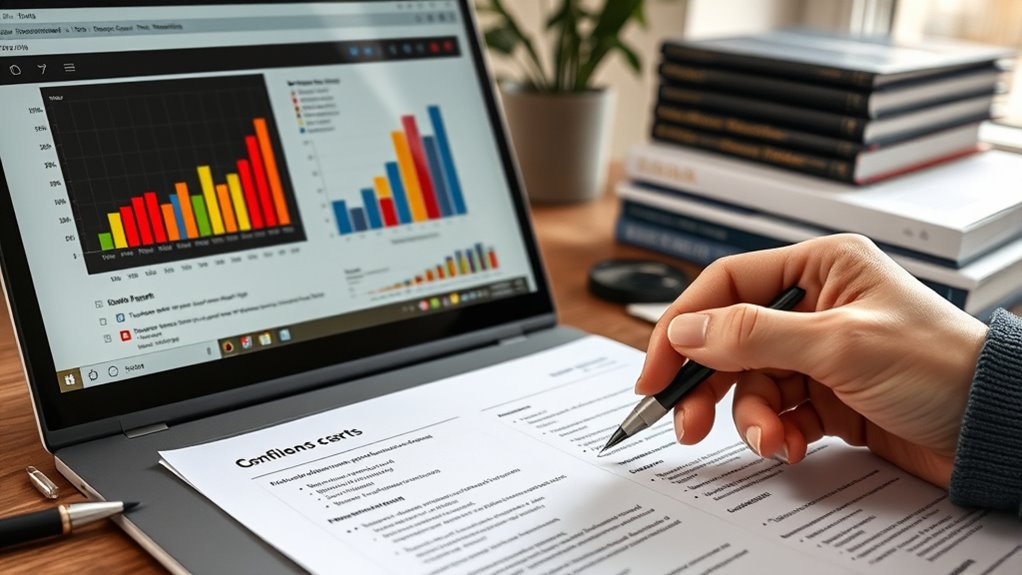To improve your statistical reports, start by using clear, structured formats that capture all key data consistently. Incorporate visuals like charts and graphs to make complex information easier to understand. Accurately showcase statistical significance and mention limitations to add transparency. Document your methodology thoroughly to guarantee others can follow your process. Finally, validate your results and focus on reproducibility to build trust. Keep exploring to discover more tips for crafting impactful reports.
Key Takeaways
- Use standardized, clear reporting formats to ensure consistency and facilitate comparison across reports.
- Incorporate visuals like charts and heat maps to enhance data understanding and highlight key insights.
- Clearly explain statistical significance, confidence intervals, and limitations to communicate results accurately.
- Document methodology, analytical techniques, and data sources thoroughly for transparency and reproducibility.
- Validate findings through robust testing, outlier detection, and sharing code or data to ensure reliability.
Use Clear and Structured Reporting Formats

Using clear and structured reporting formats is essential for producing effective statistical reports. When you use a consistent structure, it helps guarantee that all critical data elements are captured accurately, reducing errors and improving diagnostic precision. Implementing standardized formats ensures uniformity across reports, facilitating easier comparison and analysis. Standardized formats make your reports easier to understand, as they clearly present information without ambiguity. By minimizing variability, you create reliable data that can be confidently analyzed and compared across different reports. This approach also streamlines your workflow, saving time during review and interpretation. Additionally, structured reports support better organization, allowing you to quickly locate and cross-reference data. Incorporating automated testing tools can further improve accuracy and efficiency in report generation.
Include Visuals to Enhance Data Comprehension

Incorporating visuals into your statistical reports considerably boosts data understanding by making complex information more accessible. Effective visualization techniques like infographics combine charts, graphs, and illustrations to present data engagingly, helping your audience grasp trends and comparisons quickly. Bollywood legends have historically used visual storytelling to promote cultural narratives, illustrating the power of compelling imagery. Heat maps use color-coding to reveal patterns and concentrations, ideal for analyzing website traffic or financial data. Visual hierarchy guides viewers’ attention to key points, while pre-attentive attributes such as color and size highlight important insights intuitively. Bar charts are versatile for categorical data comparisons. Utilizing visualization techniques can also facilitate better decision-making by providing clear insights at a glance. Including these visuals simplifies complex datasets, making insights clearer and more memorable. They also support storytelling, helping your audience follow the data narrative effortlessly and retain crucial information longer.
Accurately Represent Statistical Significance and Limitations

How can you guarantee your statistical reports accurately convey the significance of your findings? Start by clearly explaining what statistical significance means. Emphasize that a low p-value indicates results are unlikely due to chance, not that the hypothesis is true.
Use confidence intervals to show the range of plausible values and highlight their role in conveying uncertainty.
Be transparent about the sample size, noting how larger samples reduce random error.
Avoid overstating results—remind readers that statistical significance doesn’t always mean practical importance.
Clearly state any assumptions and limitations of your analysis, such as data quality or external validity. Additionally, understanding data spoilage signs can help ensure the reliability of your data sources. Recognizing potential outliers and anomalies in your data can prevent misleading conclusions.
Document Methodology and Analytical Approaches Thoroughly

Accurately conveying the significance of your findings depends not only on statistical results but also on transparent documentation of your methodology and analytical approaches.
Start by clearly defining your study objectives, including hypotheses and research questions, to align your methods.
Begin by explicitly stating your study goals, hypotheses, and research questions to ensure alignment with your methodology.
Specify which analytical techniques you’ll use, like regression or hypothesis tests, and outline data sources to guarantee transparency.
Describe your sampling strategy to prevent bias and include plans for external validation to boost credibility.
Document data collection tools, sampling frames, and data quality checks to demonstrate reliability.
Identify the software used for analysis and explain how models are selected and validated.
Additionally, considering the materials involved in your study can influence the choice of analytical methods and interpretation of results.
Recognizing the type of data you are working with can help determine the most appropriate statistical tests and models.
Finally, clarify how assumptions will be tested and outline backup plans, ensuring your approach is reproducible and credible.
Validate Results and Ensure Reproducibility

Validating your results and ensuring reproducibility are essential steps to strengthen the credibility of your statistical reports. You should use statistical software like R, SPSS, or Minitab to analyze data for validation, employing techniques like regression analysis, confidence intervals, and hypothesis testing to assess relationships and estimate reliability. Incorporating testing methodologies ensures comprehensive evaluation of your data and findings. Identifying outliers through statistical methods helps maintain data integrity. To confirm data quality, implement data profiling, automated validation processes, and clear validation rules. Cross-validation techniques, such as data splitting and k-fold methods, test model performance on unseen data, reducing overfitting. Leverage pattern recognition, anomaly detection, and correlation analysis to verify data consistency. Additionally, applying data normalization can improve the comparability of datasets and enhance model accuracy. Finally, document your methods, share code, and ensure data accessibility to promote transparency and reproducibility in your reports.
Frequently Asked Questions
How Can I Tailor My Report to Different Audience Expertise Levels?
To tailor your report to different audience expertise levels, start by evaluating their familiarity with the subject. Use technical language for experts and simplified terms for non-experts.
Incorporate visual aids like charts or summaries to enhance understanding. Focus on implications for less technical audiences, and include detailed data for experts.
Adjust the report’s depth and complexity accordingly, ensuring clarity and engagement across all experience levels.
What Strategies Improve Clarity for Complex Statistical Concepts?
Imagine your complex statistical ideas as a puzzle. To improve clarity, break the puzzle into simple pieces, presenting each one sequentially.
Use relatable metaphors, like comparing data trends to everyday weather patterns, to make abstract ideas tangible.
Incorporate visuals like colorful charts and infographics to highlight key points visually.
Keep language straightforward, avoid jargon, and focus on why results matter, guiding your audience step-by-step to build understanding confidently.
How Should I Handle Conflicting Results in My Analysis?
When you encounter conflicting results in your analysis, first examine how different methodological choices might’ve influenced outcomes.
Conduct sensitivity analyses, testing alternative models and assumptions.
Clearly document your decisions and their rationale, and compare effect sizes with confidence intervals.
Use visual tools like forest plots to spot outliers, and consider the substantive context to determine if differences reflect real heterogeneity or study issues.
Transparency helps clarify conflicts effectively.
What Ethical Considerations Should I Include in Statistical Reporting?
When considering ethical issues in statistical reporting, you should prioritize transparency by clearly explaining your methods, assumptions, and limitations.
Respect stakeholders’ interests and privacy, avoiding data manipulation or misrepresentation.
Guarantee fairness by providing balanced perspectives and acknowledging contributions.
Adhere to professional standards, disclose errors promptly, and promote reproducibility.
Upholding these principles maintains integrity, fosters trust, and ensures your reports serve the public good responsibly.
How Can I Effectively Summarize Key Findings for Non-Technical Readers?
To effectively summarize key findings for non-technical readers, you should focus on clear, simple language that highlights the main points. Use relatable examples or analogies to explain complex ideas, and emphasize how the results impact their lives or decisions.
Incorporate visuals like charts or graphs, and keep the summary concise, engaging, and easy to understand. Always consider your audience’s interests and address potential questions proactively.
Conclusion
By applying these five powerful tips, you’ll turn your statistical reports from boring to mind-blowingly brilliant! Your data will leap off the page, making skeptics bow in awe and stakeholders hang on your every word. With crystal-clear formats, eye-catching visuals, and rock-solid validity, you’ll become the superhero of analysis. Get ready to conquer the world of data, because once you master these tricks, nothing can stop your reports from dazzling everyone!










